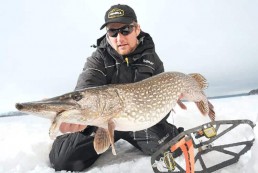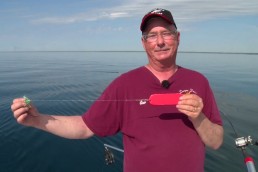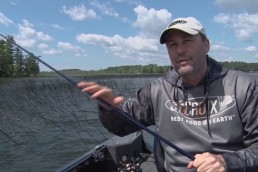High and Sly Tip-up Secrets for Trophy Pike
SHARE THIS POST
Bellied to bottom, prowling from within thick masses of weeds—that’s the most common contemplation about the whereabouts of northern pike and what they are doing there.
While it’s true that many monstrous Esox entangled in vegetation have been pulled through a hole in the ice, the truth of the matter is trophy-sized fish frequent the upper reaches of the water column more often than most anglers realize. Even within inland lakes and the Great Lakes, where depths register to triple digits, the larger the fish, the higher in the water column they might roam.
What are they doing there? Like their lesser brethren, these marauders are also searching for their next meal. After all, they didn’t get to be the biggest and “baddest” in the bunch by skimping at the buffet line. But even northern pike—thought by many to be the fiercest freshwater fish under the ice—don’t swim aimlessly under the surface when in search of food. They often rise to the occasion over the very structure the smaller fish are hunting from, or swimming directly above the breaklines beneath their bulging bellies.
In short, although trophy pike might not be lurking tight to structure, if you target the upper half of the water column very near cover, you stand a chance of catching the northern of a lifetime.
Aiming high
Walleye tournament pro Mark Brumbaugh is one of the fishing industry’s finest anglers. He’s aimed high and won many professional walleye tournaments by landing big fish where others had no idea they even lingered. Within the mix of big walleyes often were larger than average pike.
“I’ve caught a lot of big pike up high over structure in deep water when trolling for walleyes,” he says, “which led me to fish them just below the surface in close proximity to cover when ice fishing. And that’s led to catching bigger pike more often.”
Brumbaugh’s wintertime pike-ploy usually involves a swath of tip-ups strategically placed midst various types of structure, aiming specifically at weeds, wood and rock adjacent to drop-offs, especially those nearest points, cuts or any irregularity in an otherwise relatively straight breakline.
Once his holes are drilled, Brumbaugh reaches for only the liveliest of minnows to be nipped onto his treble hook (he relies on a Frabill Aquatic Bait Station). “Because a tip-up is a hands-off device,” says the Ohio fisherman, “I want only the healthiest bait. The bait must wiggle – a lot. And it needs to stay alive a long time, so I don’t have to spook fish by checking tip-ups too often.”
Are you enjoying this post?
You can be among the first to get the latest info on where to go, what to use and how to use it!
Brumbaugh skewers the minnow closer to the tail than the head, often hooking it through the bottom of its tail section so that it’s always struggling to right itself. “The minnow never quits squirming if you hook it here,” he points out. “Little details like this are important.”
One trouble anglers often have with tip-ups is getting their offerings back down to the same sweet-spot depth they just banked a fish at. Frabill’s Calibrator Line Counter Tip-Up lets you know the exact depth of your bait.
Walk softly
A major mistake Brumbaugh sees anglers make is creating too much noise.
“Often, the fish are swimming just feet under the surface,” he says, “and any noise out of the ordinary will spook both baitfish and prey from the area. Sound travels faster and farther under water than through air, so anglers need to take every step as quietly as possible.” One way to lessen the need to move around is using a GPS coupled with a mapping program to find drop offs, humps, holes and other attractive lake features. From the iced-over waters of Minnesota, guide Brian “Bro” Brosdahl uses a Humminbird sonar/GPS equipped with LakeMaster digital contour maps. He’s able to quickly locate probable fish holding places. And if there’s success, Bro logs the spot for a pinpoint return trip.
Electronics in hand with mapping program, Bro makes a beeline to key structure, drills, sets, and tiptoes away from the field of flags. “Adding covertness to ice fishing,” says Bro, “is probably one of the most overlooked reasons to use electronics.”
On the sly
Employing crafty equipment is as important as being stealthy yourself. Bright light seeping through a hole around a tip-up can cause alarm under the ice. Tip-ups that envelop the entire hole, such as a Frabill Pro Thermal Insulated Tip-Up, keep sunlight out and fish at ease. This unique style of tip-up also insulates the hole, helping to keep it from refreezing, making it easier to remove the device after a fish hits.
If it’s numbers you’re after, work the weeds. But if your fishing clan is willing to invest in a trophy hunt, forgoing the button-bucks, fawns and eater does, there might be a “turdy-pointer,” or rather a “turdy-pounder” bedding out over the basin.
MWO
SHARE THIS POST
Did you enjoy this post?
You can be among the first to get the latest info on where to go, what to use and how to use it!



